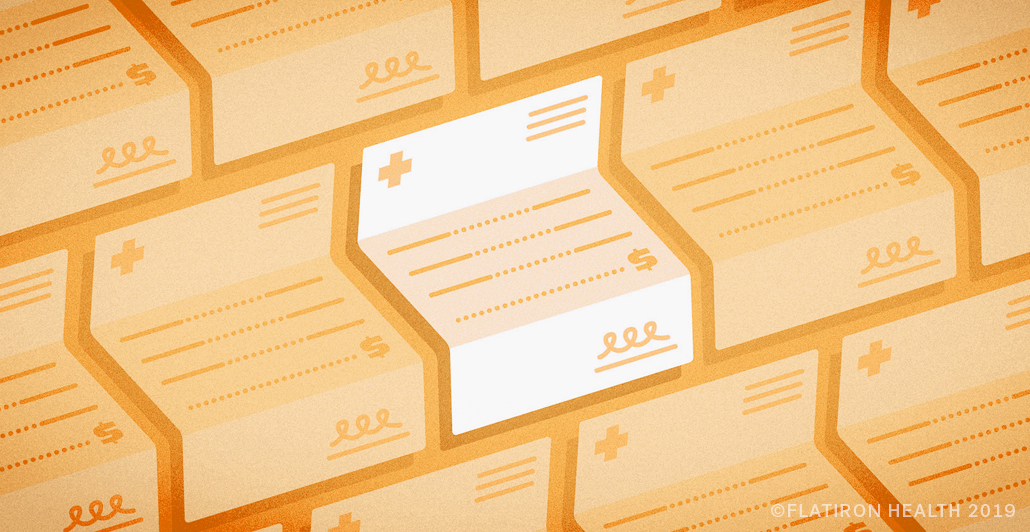Put simply, cancer patients who suffer from financial stress have worse outcomes. The American Society of Clinical Oncology's (ASCO) Journal of Clinical Oncology found that patients "with limited financial reserves reported significantly increased pain…, greater symptom burden..., and poorer [quality of life]." But why should your ability to pay a bill impact the outcome of your cancer?
In the U.S. healthcare system, as we know, patients are required to pay for anything that their insurance doesn't cover: their doctor's time and expertise, the treatment they receive, drugs prescribed to help with side effects, etc. These costs can lead to additional stressors and negative outcomes, such as: accumulating debt, inability to afford and subsequent missing of future treatments, inability to afford basic costs of living, and even declaring bankruptcy. Many people with cancer cannot work, and losing their only source of income only exacerbates the problem. This is known as "financial toxicity".
Research has found that chronic stress can cause a whole host of problems that make it harder for a person to recover, both physically and mentally, from cancer treatment. Combine the stress, the cancer itself, the treatment, and the finances, and the situation can become unbearable for many patients.
The term "financial toxicity" was coined in 2013 by Dr. Amy Abernethy and Dr. Yousef Zafar in their journal article about the patient-level impact of the cost of cancer care. The National Cancer Institute has a number of articles about financial toxicity and its impact, starting here . As discussed in the October 23, 2018 episode of the ASCO in Action podcast, ASCO's CEO Dr. Hudis says "that many patients ‘are not taking their prescribed medication because of cost, they're drawing down their savings when they have savings, and they're often not paying their other household bills, or taking other drastic measures because the cancer treatment that they have to receive has become so expensive.'" An October 2018 study published in The American Journal of Medicine found that after two years of treatment "42.4% [of cancer patients] depleted their entire life's assets, with higher adjusted odds associated with worsening cancer."
How can we solve this problem?
There are two primary approaches to reducing patients' financial burden, the first being lowering the cost of cancer care. While this is crucial work that's happening across the political and private sectors, we're not going to address that in this blog post. The second approach is to identify financial resources for patients to cover the costs of their care. We often think of a primary insurer as the only way to reduce the cost of cancer care, but there are other ways that can be hard to identify without knowing the ins and outs of medical billing.
Here's an example of how financial resources can come into play:
Imagine for a moment that a patient, who we will call Maria, has an insurance plan from Insurance Company X that has a 20% co-insurance, meaning that she's responsible for 20% of her medical bills (until she reaches her deductible). Maria has breast cancer and is being treated with a targeted therapy for breast cancer. She has a co-pay card from Pharma Company X, the pharmaceutical company that makes the drug with which she is being treated, to help cover her costs for the drug. Maria has $500 left until she reaches her deductible.
Each time Maria sees her doctor for treatment, it costs $2,500 per infusion plus an additional $1,500 for the doctor's visit, lab and administration costs -- a total of $4,000 per visit. With her 20% co-insurance, Maria is responsible for paying $500 for the drug and $300 for the other costs. However, Maria has a co-pay card from Pharma Company X that covers her responsibility to pay for the cost of the drug, so she only has to pay $300 out of pocket instead of $800.
A lot of patients don't know about co-pay cards because they're not well advertised. Doctors -- patients' primary point of interaction with the doctor's office -- don't always know about them, and many community oncology offices don't have financial counselors on staff. There are many cards that exist for a wide range of treatments, and for patients whose insurance providers don't allow for co-pay cards (e.g., some government payers), there are grants and foundations that provide similar support. However, even if a patient finds a co-pay card, grant, or foundation for the specific drug with which they will be treated, figuring out eligibility and coverage options is still very complicated.
Where design and technology come in
Finding additional financial resources is not the only way to help alleviate the cost of care for patients. Companies who build software can use design and technology to help doctor's offices find the financial resources for their patients without hiring additional staff, something that they likely don't have the resources to do. Here are some areas where we can begin to move the needle:
Easier identification of financial resources
Patient assistance programs are usually sponsored by pharmaceutical companies and provide free or discounted prescriptions to low-to-moderate-income, uninsured, and underinsured patients who meet certain guidelines.
If we make it easy for a doctor's office staff to enroll patients in appropriate programs, then we can chip away at the costs that would otherwise fall on the patients. Proactively notifying staff about programs that their patients may qualify for and making it easy to submit enrollment forms is a good start. A lot of the information needed for these forms already exists in patients' medical records, so data entry can be accelerated, or in some cases eliminated, by leveraging existing data.
Smarter billing
Think back to Maria's situation laid out above -- Maria is responsible for $500 of the drug cost and $300 of the additional costs, but she also has a co-pay card for the drug as well as $500 left to reach her deductible. Under normal circumstances, these charges will be billed to the insurance provider in an arbitrary order. For example, many medical offices would first bill the doctor's visit, lab and administration costs, then the cost of the drug. Maria will then pay her $300 portion of the additional costs and her co-pay card will cover the drug up until her deductible is reached.
If we switched the order by billing the drug first, the co-pay card will cover Maria's $500 portion for the drug, which means she reaches her deductible and will not have to pay anything for the doctor's visit, lab and administration bill.
Maximize costs covered by insurance providers and other payers
When a doctor's office receives payments from insurance providers, there may be uncovered balances that need to be paid by the patient. We can design their billing system to exhaust all possible sources of payment -- e.g. secondary insurance, tertiary insurance and patient assistance programs -- before passing costs onto patients. In Maria's case, the billing system could automatically bill the cost of the drug to Pharma Company X so that she never has to see it on her bill.
By enabling billers to more efficiently and accurately handle payments, we can mitigate tedium and help them focus on work that helps alleviate patients' financial toxicity.
How do we do this?
We haven't discovered every financial resource available to help cancer patients, but with software design, we can make it easier to do this from within doctor's office billing software to address the needs of patients suffering from financial toxicity.



